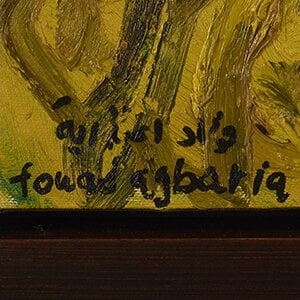


Last updated on Sat 21 April, 2018

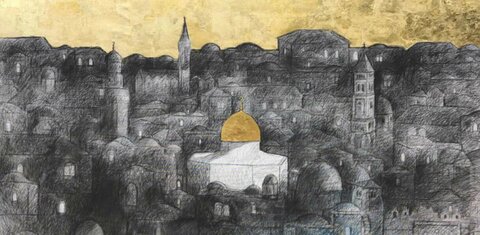
JERUSALEM: 51 YEARS OF OCCUPATION
April 21 – June 14, 2018
Zawyeh Gallery
The overwhelming significance of the physicality of Jerusalem as a national symbol permeates many of the artworks. The iconic representation of the Dome of the Rock comes to the fore as some artists celebrate the city via exceptionally colourful works especially those by Fouad Agbaria, Ibrahim Nobani, Osama Said, Dina Mattar, the late Issam Bader and to an extent Ahed Izhiman. Conversely, a strong sense of melancholy and grief overshadows the charcoal works of Nabil Anani, Hosni Radwan and the photorealism painting of Adam Shehada were the city loses its colour. Similarly, Sliman Mansour calls in his artwork upon the ghosts of the past to haunt the city’s present time. Khaled Hourani presents a man struggling to hang up a sign of Jerusalem written in Arabic. The Wall in Tayseer Barakat and Mohammad Joulani’s artworks is a prominent feature while Fayez Sirsawi presents a diary of students’ daily life under occupation.
The exhibition also showcases contemporary artists’ perspectives on the socio-political issues surrounding the city’s ongoing occupation. The racial discrimination practices towards Palestinians by the Israeli regime is the subject of Yazan Khalili’s artwork, while Benji Boyadgian’s work is a journey in time in the midst of the complex and fragmented Palestinian landscape of the 21th century “Mega Jerusalem”. Rana Samara’s work focuses on the sights of demolished homes highlighting Israel’s ilegal policy of house demolitions and ethnic cleansing. Rehab Nazzal’s photography work focuses on demonstrations against the Israeli regime’s policies in the city through an ironic scene that reveals from a distance a masked demonstrator taking a rest amid a cloud of intensive smoke. Michael Hallaq on the other hand explores touristic objects that can be found abundantly at souvenir shops around the city, capturing a different layer of “the holy” city that remains popular with tourists even though it is detached from reality. Rawan Khaliliyeh’s artwork is an exploration of the aesthetics of old wooden slabs that are used in building sites, which are scarce in the eastern part of the city due to building restrictions. Vervara Razak attempts at combining traditional symbols presented in the transformation of a Knafeh triangular piece into a traditionally embroidered cushion sold in souvenir shops.
Adam Shehada
Adam Shehada was born in Gaza in 1991. A self taught hyper-realistic artist, his work carries alot of emotions which stems from his ongoing suffering due to the Israeli occupation.
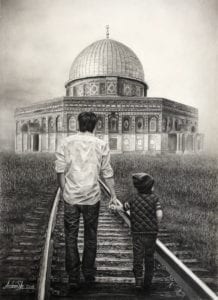
Shehada considers practice and patience as key attitudes in refining artist’s skills. He works with pencil and charcoal because he formed a strong “love bond” with this medium when he was a child. Even though he is able to produce astonishingly realistic works, he believes that he has not yet discovered his full potential with this simple tool.
Shehada has been invited to exhibit his first debut collection titled Inextinguishable Suns in Britain’s prestigious House of Parliament, London’s Open Ealing Gallery, and other locations. But unfortunately, he has not been able to find a sponsor for his trip to accompany his works, and thus cannot realize one of his most important dreams: to see with his own eyes the world beyond Gaza.
Benji Boyadgian
Benji Boyadgian (FI/PS) born 1983, Jerusalem. Studied architecture at ENSAPLV School of Architecture (L’Ecole Nationale Supérieure d’Architecture de Paris La Villette), specializing in urban sociology in post-conflict areas.
Boyadgian works on research-based projects that explore themes revolving around perception, heritage, territory, architecture and landscape. He works with multiple mediums, spacial installations, and employs painting and drawing as his primary tools for conveying his subject matter.
His recent exhibition include; 2017: Sharjah Biennial 13 Offsite: Shifting Ground, Khalil Sakakini Cultural Center, Ramallah; Armenia Standart: Mount Anlalogue, Gyumri; Around About: Khalil Sakakini Cultural Center, Ramallah; AQUA, Contemporary Artists and Water Issues, Chateau de Penthes, Geneva; The Discord, Al Ma’mal and Anadeil Gallery, Jerusalem; 2016: Traces, Art Rooms, Kyrenia; The Jerusalem Show VIII: ‘Before and After Origins’, Al Ma’mal Foundation for Contemporary Art, Jerusalem; De lova de oss en skola, de lovade en Simhall, Skånes konstförening, Lund ; Lines of passage (in media res), the Municipal Art Gallery, Lesvos; 2015: Line, Art Rooms, Kyrenia; Stepping over the Borders, European Mediterranean Art Association (EMMA), Nicosia; Shared Religious Places, Museum of European and Mediterranean Civilizations (MuCEM), Marseille; 2014: The Jerusalem Show VIII: ‘Fractures’, Al Ma’mal Foundation for Contemporary Art, Jerusalem; and Curated-By: Spinning On An Axis, Mario Mauroner Contemporary Art, Vienna.
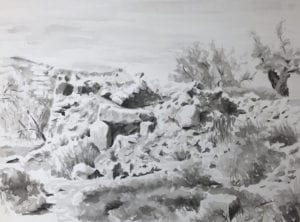
Boyadgian attended the Young Artists Residency Program of Confrontation Through Art Project, organized by EMAA and Rooftop Theatre Group, Nicosia; Grant holder, IASPIS, Stockholm; He was been awarded the Ismail Shammout Prize (2015) in Palestine.
Boyadgian lives and works in Jerusalem.
Hosni Radwan
Hosni Radwan was born in Baghdad in 1955. He studied fine arts at the University of Baghdad specializing in graphics. He held a number of solo exhibitions in Iraq, Lebanon, Cyprus, Japan and Palestine. Radwan took part in international biennales including those of Berlin, Cairo and Sharja. He left Baghdad in 1979 and headed to Beirut where he worked in graphic design and journalism while continuing to draw and paint using his talents to express his position vis-à-vis the cause of his people.
He has exhibited widely and his solo shows have been held in cities including Tunis (1993); Tokyo (1985); Nicosia (1983); Ramallah (2003 ,2002 ,1997, 2017); Baghdad (2001) and Kuwait (2008). Radwan currently lives and works in Ramallah.
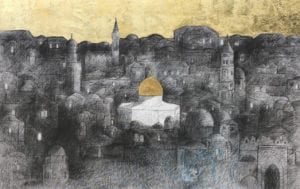
Nabil Anani
Nabil Anani (b.1943, Latroun, Palestine) is one of the most prominent Palestinian artists working today. He is considered by many as a key founder of the contemporary Palestinian art movement.
On graduating in Fine Art from Alexandra University, Egypt [in 1969], Anani returned to his native Palestine and began a fruitful career as an artist and a teacher trainer at the UN training college in Ramallah. Anani held his first exhibition in Jerusalem in 1972 and has since exhibited widely in Europe, North America, the Middle East, North Africa and Japan – both as an individual artist and with groups of his Palestinian contemporaries.
Anani is a multi-talented artist, for he is a painter, a ceramicist and a sculptor. He pioneered the use of local media such as leather, henna, natural dyes, Papier-mâché, wood, beads and copper. Over the past four decades, Anani has built an impressive catalogue of outstanding, innovative and unique art.
Anani was awarded (by Yasser Arafat) the first Palestinian National Prize for Visual Art in 1997 and became the head of the League of Palestinian Artists in 1998. On retiring from his teaching post in 2003, Anani has dedicated much of his time to voluntary pas- times, leading on the League’s activities and playing a key role in the establishment of the first International Academy of Fine Art in Palestine – with the assistance of the University of Oslo and the Norwegian Ministry of Foreign Affairs.
Sliman Mansour
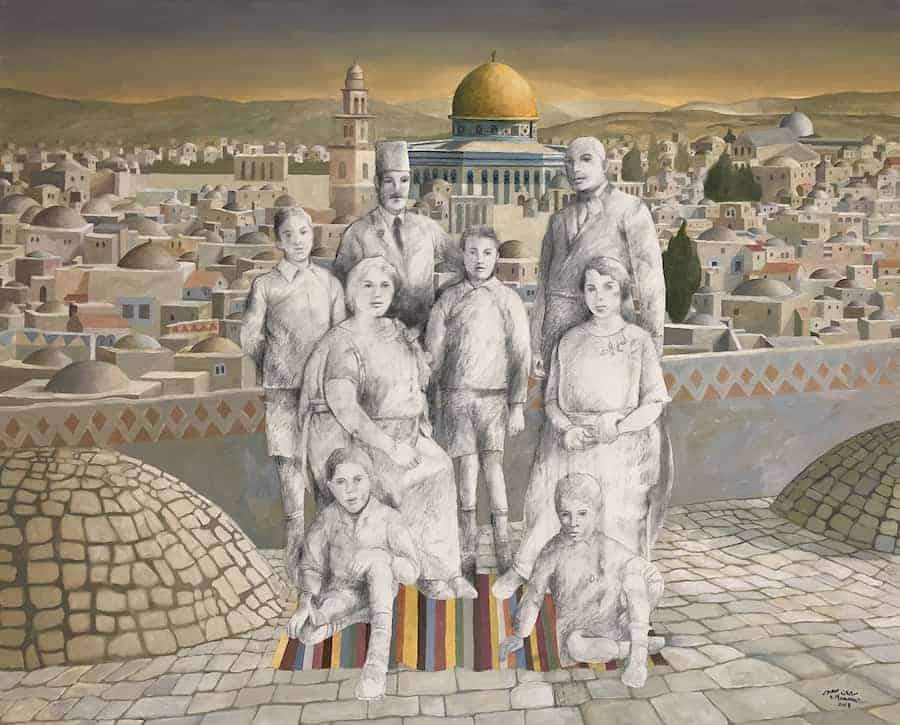
Born in 1947, Birzeit, Palestine, Sliman Mansour studied fine art at the Bezalel Art Academy in Jerusalem. He has held solo exhibitions in Ramallah, New York, Sharjah, Cairo, Gaza and Stavanger, Norway. His group exhibitions include Museum of Oriental Art, Moscow (1980), Palestinian Spring, Al-Hakawati Theatre, Jerusalem, 1985; New Visions, Jordan National Gallery of Fine Arts, Amman, 1991; Made in Palestine, Station Museum of Contemporary Art, Houston, Texas, 2003; and Contemporary Graphic Art in the Arab World, Nabad Gallery, Amman, 2010. In 1998 he received the Palestine Prize for the Visual Arts at the Cairo Biennial. Sliman Mansour draws inspiration from the subject of the olive tree, and has focused on the theme of ‘land’ since 1970. His recent work is centred on the individual figure to convey the ‘different states of exhausting anticipation or loss,’ resulting from his experience of living under the occupation.
Michael Halak
Michael Halak was born in 1975 in Fassuta village (Upper Galilee). He currently lives and works in Haifa. In 1999-2002 he studied Fine Art at Haifa University. In 2005 he won a residence scholarship at the Florence Academy of Art in Italy. In 2007-2009 he studied M.F.A at Haifa University. Halak is a realistic painter whose works focus on classical subjects such as portraits, landscapes and still lifes with a contemporary twist. He has had solo shows at Tel-Aviv Museum of Art, Noga Gallery in Tel-Aviv and Haifa University Art Gallery. He also exhibited in many group shows such as Haifa Museum, Herzelia Museum and other galleries in the Middle East, Europe and the United States.
Halak won several awards including: Israeli Ministry of Culture and sports for contemporary artist (2015), The Rappaport prize for a young painter (2011), the Israeli Ministry of Culture and Sports Award for young artists (2010), and the Pais Culture Council support in Exhibition (2012-2016).
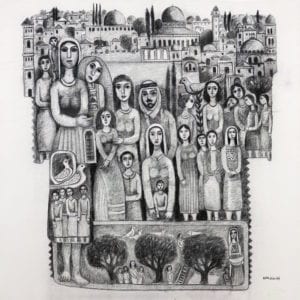
Michael Halak’s paintings belong to the Western tradition of realist; illusory painting that goes back hundreds of years. The drama and turmoil in his works are given contemporary expression and reflect his connection to this particular place and time. Halak’s paintings address the immediate reality that surrounds him by means of direct observation or photographs. The illusion of reality represented on canvas is seductively beautiful and perfect, yet it is simultaneously revealed to carry a disturbing charge, which is related to states of disruption and disintegration.
His works charged with the central tension that shapes both his life and his work; the question of the connection between man and place, and related concerns regarding presence and absence, identification and dis-identification, witnessing and silencing, memory and intentionally imposed oblivion.
Ibrahim Nubani
Ibrahim Nubani was born in Acre (1961); he studied art at Bezalel, the Academy of Art and Design in Jerusalem. He lives and works in the village of Maher in the Galilee. Nubani is perceived as a controversial artist, who difies the colonialist Israeli system. His fa- ther grew up in Haifa, and after the Nakba was forced to abandon his home for Acre and settle there.
In Nubani’s creations, abstraction is not only a “condensation”, its also an attempt to distance himself from the approach of a re- port or of documentation in order to reach the heart of an idea or its essence, and to express soulful and spiritual energy, which is the artistic parallel to freedom and liberation. Nubani has held a number of solo and group exhibitions locally and internationally.
Fouad Agbaria

Born in the village of Musmus near Umm El Fahm in 1981, Fouad Agbaria is one of the most prominent young Palestinian artists working today. Agbaria attained a bachelor’s degree from Bezalel Academy, Jerusalem in 2004 and a master’s degree from Haifa University in 2014.
Since completing his undergraduate degree, Agbaria has painted prolifically often experimenting with different styles, techniques and media including charcoal, oil, acrylic and lithography. His catalogue of work to date has dealt with many themes associated with the Palestinian narrative, identity and memory. He has participated in over 20 group exhibitions and has held four solo shows. Agbaria lives and works in Um Al-Fahem.
Khaled Hourani

Khaled Hourani (b. Hebron, 1965) is a Palestinian artist, curator, and art critic. He is the initiator of the project Picasso in Palestine. He attained a BA in History from Hebron University and was awarded the title of Cultural Management Trainer by Al Mawred Cul- ture Resource and the European Cultural Foundation (Egypt). He has had several solo exhibitions locally and internationally and participates frequently in group exhibitions. Hourani has curated and organized several exhibitions such as The Young Artist of the Year Award for the years 2000 and 2002 for the A.M. Qattan Foundation, Ramallah. He was the curator of the Palestinian pavilion for Sao Paolo Biennale, Brazil and the 21st Alexandria Biennale, Egypt. He writes critically in the field of art and is an active member and founder of artistic and administrative boards in a number of cultural and art institutions. Hourani was the Art Director of the International Academy of Art Palestine (2007-2010). He currently lives and works in Ramallah.
Issam Bader
Issam Bader was born in 1948 in Hebron. He graduated from the Baghdad Fine Arts Academy, and received his Master’s in Ceramics from the Tbilisi Academy of Fine Arts in Georgia. He has held 10 personal exhibitions and participated in a number of group exhi- bitions in Palestine, Cairo, and Tokyo. In 1979, he founded the first Gallery in Ramallah (Gallery 79) which was a center of cultural activities and a showcase of Palestinian art in the early 80’s till it was closed down by the Israeli military authorities. Issam Bader passed away in November 2003 in Ramallah.
Rehab Nazzal
Rehab Nazzal is a Palestinian-born multidisciplinary artist based in Canada and Palestine. Her video, photography and sound works deal with violence of settler colonialism. Nazzal’s work has been shown in Canada, Palestine, and internationally in both group and solo exhibitions, including Prefix Institute of Contemporary Art, CONTACT Photography Festival, Toronto Images Festival, A Space Gallery, Toronto; Karsh-Masson Art Gallery, Ottawa; AXNEO 7, Quebec; McIntosh Art Gallery, London; Toronto-Palestine Film Festi- val; United Art Society, Alberta; Khalil Sakakini Cultural Center, Ramallah; Art Gallery of Mississauga; the San Francisco Museum of Modern Art, the Spanish Institute of Art, and the International Durzfilmtage Oberhausen, Germany.
Nazzal holds a PhD in Art and Visual Culture from Western University in London, Ontario, an MFA from Ryerson University in Toronto, a BFA from the University of Ottawa, and a BA in Economics from Damascus University in Syria. She is a recipient of the Social Sciences and Humanities Research Council of Canada (SHRC) doctoral award, Ontario Graduate Scholarship (OGS), Canada Council for the Arts, Ontario Art Council, and City of Ottawa. She has received awards from Ottawa University, Ryerson University and University of Western Ontario.
Ahed Izhiman
Ahed Izhiman is an artist who was born in Jerusalem in 1980. Ahed has worked as a photography consultant and freelance photog- rapher for the past ten years. Since 2001, he has contributed to community organizations as a young artist, art lecturer and fine art professional trainer, and is one of the co-founders of Art Lab, the first office-sharing project for artists in Jerusalem. His works have been widely presented in national and international exhibitions. Izhiman currently lives and works in Jerusalem.
Mohammad Joulani
Mohammad Joulani (b. 1983, Jerusalem) earned a Bachelors degree in Fine Arts from Al Quds University in 2009 where he taught visual art between 2011 and 2013.
Joulani received the Higher Education Award in 2007 and the 2nd prize for the Ismail Shammout Fine Arts Award, 2016. He is one of the founding members of the Visual Artists Club in Jerusalem.
Joulani participated in his first solo exhibition; Regular Day, Open gallery 3rd Edition at the Al Hoash Art Court in Jerusalem, Occu- pied Palestine (2016). He also participated in many local and international group exhibitions, including; Reviewing Jerusalem #2 Return, Qalandiya International 3rd edition, Al Hoash Art Court, Jerusalem, Occupied Palestine (2016); Sumoud, Ismail Shammout Award in Fine Arts, Diyar consortium, Bethlehem, Palestine (2016); Colors of Life, Zawyeh gallery, Ramallah, Palestine, (2014); Fes International Festival for Arts in Morocco (2013); Frau Museum, Bonn Germany (2013); Room of Hope, Diyar Consortium, United States (2011); and other participations in Egypt, Malaysia, Italy and the Netherlands.
Rawan Khalilieh
Rawan Khalilieh (b. 1991, Nazareth) is a Palestinian artist and an art graduate from Haifa University (2016). Khalilieh participated in a number of workshops in a variety of cultural fields in addition to working for local institutions. She was shortlisted for Ismail Shammout Annual Award organized by Dar Al Kalimeh University in Bethlehem and has won the first prize (2018).
Yazan Khalili
Yazan Khalili, born in 1981, lives and works in and out of Palestine. He received a BA from Birzeit University, an MA from the Centre for Research Architecture at Goldsmiths, and an MFA from the Sandberg Institute. He was co-founder of Zan Design Studio and the winner of Extract V Young Art Prize 2015. Solo shows include No one Saw the Colors at Gl Strand, Copenhagen, On the Other Side of the Law at Lawrie Shabibi, Dubai, On Love and Other Landscapes at Mumbai Art Room, Mumbai, and Imane Fares Gallery, Paris, The Aliens at Transit Gallery, Mechelen, and Regarding Distance at E.O.A.Projects, London. Group shows include Being: New Photography, MoMA, Post-Peace, Württ. Kunstverein Stuttgart, Al Riwaq Biennial Palestine, the Jerusalem Show, Searching for a Presentat Espoo Museum of Modern Art, the Shanghai Biennale, The Plough and Other Stars at the Irish Museum of Modern Art, A Million Lines: XII Baltic Triennial, La Mer au Milieu des Terres//Mare Medi Terraneum at Es Baluard, the Berlinale, and Sharjah Biennial. He teaches at Al-Quds Bard University, and currently the director of Khalil Sakakini Cultural Centre.
Tayseer Barakat
Tayseer Barakat was born in Jabaliya refugee camp in Gaza in 1959 and carried out his arts education in Alexandria, Egypt, in 1983. After completing his studies, he moved to Ramallah where he has been based ever since – both teaching and creating art.
Barakat has worked with a variety of materials and has experimented widely – with wood, metal and glass –, becoming one of Palestine’s foremost artists working today. Painting remains his first love and he continues to work at a prolific rate, drawing on the artistic heritage of the region and its ancient influences, and of Palestine, the Palestinian people and the Palestinian spirit.
Barakat has held 10 solo exhibitions and has participated in numerous group exhibitions with many of his contemporaries in Japan, USA, Brazil, Europe and across the Arab world.
Osama Said
Osama Said was born in 1957 in the small town of Nahaf, located between Lower and Upper Galilee. Said started his career in art with a degree in fine arts in Berlin. After graduating with high honors from Hochschule der Künste, he was granted several schol- arships, awards, and residencies that encouraged and expanded his artistry whilst allowing his stay in Germany to last 16 years. Having painted for years while abroad with only memories of Palestine, Said was struck by the painful reality of Palestinian life upon his return. As a result of his discoveries, Said’s work portrays the different faces of nature. Upon closer examination, howev- er, viewers will find several layers of color that present themes of memory and forgetfulness; identity and alienation; illusion and reality. The painting of the Palestinian landscape that appears in most of his drawings attests to the loss of Palestinian land in 1948 and the continuous political reality of struggle over the land.
Dina Mattar
Dina Mattar (b. Gaza, 1985) graduated with a BA in fine art and education from Al Aqsa University in Gaza in 2007. Her work has been exhibited in many exhibitions in Palestine and regionally, as well as in Europe, USA, South America and the UAE. In 2012 she was an artist-in-residence at Cité International des Arts in Paris. She lives and works in Gaza, and is a member of the Eltiqa artists’ collective.
Varvara Razak
Varvara Razak was born in Belarus. She completed her studies in Contemporary Art at Dar Al-Kalima University of Arts and Culture in Bethlehem (2017).
Razak is a multidisciplinary artist, primarily using painting, photography and video to express her concepts. Her themes are very much inspired from the daily life in Palestine, the political situation, and especially Human Rights issues.
Razak participated in a number of group exhibitions in Palestine and USA. She was awarded third and second prizes in the Palestinian Photo Marathon (2015-2016); Ismail Shammout Prize at Dar Al Kalima University (2016) and the first award of the Palestinian Anticorruption Competition (2017). Razak currently lives and works in East Jerusalem.
Fayez Sirsawi
Fayez Sirsawi was born in Gaza (1961). He holds a master’s degree in sculpture from the Fine Art Academy at Mimarsina University of Istanbul (1986). Sirsawi exhibited widely in Palestine and abroad. He was also an artist in Residence at Cité Internationale des Arts in Paris (1999 2000). Al-Sirsawi currently lives and works in Gaza.
Rana Samara
Rana Samara (born 1985, Jerusalem) is a Palestinian artist and a graduate of the International Art Academy, Ramallah (2015). Samara’s current body of work – Intimate Space – explores societal norms, sexuality, gender roles, and other factors associated with modern Palestinian life. Her work focuses on the less obvious factors that underpin the daily lives of women who reside in overcrowded refugee camps and rural communities – women whose lives continue to be blighted both by conservative traditions and the exigencies of life under occupation.
Focusing on marital intimacy, Samara demystifies many social taboos and translates these onto large, bold and colorful canvasses that are both remarkable social statements and beautiful artistic constructs. Frank conversations with women form the backbone of her work that transcends the private space into the realm of the public. Often depicting the aftermath of sexual encounters, Samara’s paintings are remarkable visual metaphors of the lives of Palestinian women existing in restricted environments, cramped and constrained by internal traditions and by external forces.
Samara is a highly inquisitive, courageous and determined artist. These characteristics propelled her – in the first place – to pursue a bachelor’s degree in Fine Art as a mother of three children from a conservative background. Her passion for art and formidable determination has led her to pursue further studies in Fine Art and Theory at Northwestern University, Chicago.
Samara has participated in group and solo exhibitions in Zawyeh Gallery, Ramallah and her works has been shown in Dubai Art Fair (2017) and Beirut Art Fair(2017).
Join us in our endless discovery of modern and contemporary Arab art